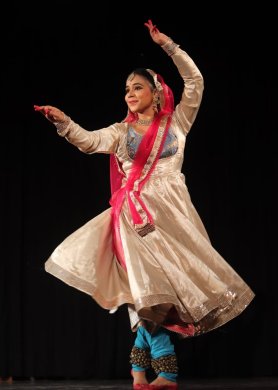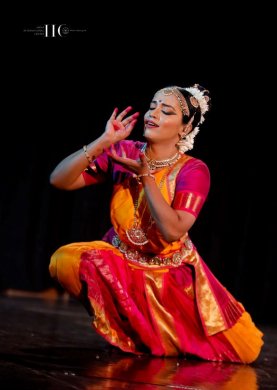
|   |

|   |
 e-mail: leelakaverivenkat@gmail.com Promising young talents in double-bill concert July 20, 2023 Battling against surging traffic on roads battered by Delhi's unexpected rain deluge, to arrive finally at India International Centre's Deshmukh auditorium was well worth the effort, to watch a couple of promising youngsters representing Kathak and Kuchipudi respectively, featured in the Centre's Double Bill Concert.  Minu Garu Minu Garu trained under Kathak Guru Krishan Mohan Maharaj, combined grace in ang with bodily agility. While her guru presided over the concert providing parhant lead, the dancer's footsure rhythm and relaxed utterance of bols before each intra-form spoke of a meticulously trained performer, not afraid of nritta challenges. Teental presentation both in the medium tempo of the first section to the accelerated drut second part, showed a poised dancer, her ang sanchalan comprising delicate angles of torso with hand and wrist manipulations along with the footwork, blending into a totality of technique involved in Kathak nritta (from thata to various sequences like Amad, Paran, Tihai etc), representing technique, largely of a non- representational character. Krishna Mohan's quick interventions informed on how aspects like Ginti Tihais have, under late Birju Maharaj's genius acquired a special dimension, and how patterns emerge through the placing and accenting of numbers in a nritta ad-form and how certain vowels like thalang are translated into movement preserving the sound. This, along with a coordinated musical team (Rahul Vishwakarma on tabla, Jai Dadhich providing tuneful vocal support for the Thumri, and the lehra refrain by Ghulam Mohammad on sarangi and Fateh Ali Khan on Sitar) accompanying the competent dancer, whether in a Thata section, a Gat, or a speedily performed ladi, added up to a synchronized presentation.  Minu Garu's music accompanists The abhinaya part comprising a Bindadin Thumri in raag Basant Hindol, "Mohe chedo na, Nand ke sunahoon chail", while revealing a dancer who has the wherewithal for expressional depiction, required more subtlety in bringing out the double edged attitude of the gopi, who, while desirous of Krishna's attentions and not totally averse to his teasing, keeps a wary eye on prying women who will gossip about his flirtations, not to speak of the in-laws at home who will reprimand her. To evoke that flirtatious blend of desire lurking beneath outward rebuke requires finesse in gestures and expression, which specialized training imparts.  Meenakshi Aishwarya It was heartening to watch good, old fashioned Kuchipudi sans frills, by Meenakshi Aishwarya from Coimbatore, training under Sreelakshmi Govardhanan, trained under stalwart Pasumarthy Rattiah Sarma, apart from other artists like Vyjayanthi Kashi and Manju Bhargavee. Right from the start with Ardhanareeswaram set to raga Mayamalawagoula, Meenakshi's ability in bringing out the complementary male/female contrasts (on the right half Shiva the Jagadeesha pitha), father of the universe in his Kapalamala, partnered on the left half by the gentle graces of Parvati as World Mother, succeeded in establishing her credentials as an accomplished performer. Manduka Sabdam for this critic was the highlight of the presentation. Evolving during the 17th century, composed by Melattur Kashinatha Pandit according to historians, the Sabdam describing mythological, cultural, historical and social stories of events and happenings in a narrative style, is one of the significant items of traditional Kuchipudi repertoire - getting to be less common nowadays. The Nayaka and Maratha rulers provided special patronage for dance traditions like Yakshaganam, Pagativesham, Veedi Bhagavatam - all catering to the natya tradition. Set in Kuchipudi's favourite raga Mohanam, Manduka Sabdam woven round the narrative of the frog princess who transforms into the beautiful Mandodari, whom Ravana falls in love with and carries away to Lanka as wife, has sahitya comprising syllables like tagam, nagam, jagam (nagana naga naga, degada dega dega, Jagaja jaga jaga) representing different rhythmic patterns specifying movements of the leaping frog and of other life thriving in the waters of the pond. The presentation form has the dancer addressing King Krishna Devaraya, relating to him the story the frog princess - highlighting the dramatic tradition with a solo dancer taking on several roles as narrator. It brought back for many, the flavor of the seventies and eighties when the likes of Indrani Rehman, Yamini Krishnamurthy, Rita Devi, Sumathy Kaushal treated this item as a must. Dancer Aishwarya was as relaxed while leaping like a frog, as while depicting a beautiful princess, catching the eyes of the powerful Ravana driving his chariot, and succeeding in becoming the queen of Lanka. Next in a pure abhinaya stint, came the Gitagovinda Ashtapai "Sakhiye, Keshi mathanam udaram" showing love stricken Radha pleading with her sakhi that she fetch 'the killer of Keshi' to her side, while reminiscing on moments of her first intimacy with Krishna, and how his love play had made her overcome her bashfulness. The sakhi's significant role enables the estranged lovers to unite with Krishna finally wooing Radha to become one with him in the Ashtapadi "Kishalaya sayana tale kuru kamini charana nalina vinivesham". Concluding on an energetic note with Annamaiyya's composition on Vishnu as the ferocious man-lion Narasimhudu, with the music set to a peppy ragam Arabhi, the dancer ended her recital with a final salutation to the audience. With recorded musical accompaniment allowed for out-of-station young dancers of this festival, the dancer, who took care to thank all the persons enabling her selection and presentation at the IIC, missed out by not mentioning the names of the unseen singer and instrumentalists on tape, without whom she could not have performed.  Writing on the dance scene for the last forty years, Leela Venkataraman's incisive comments on performances of all dance forms, participation in dance discussions both in India and abroad, and as a regular contributor to Hindu Friday Review, journals like Sruti and Nartanam, makes her voice respected for its balanced critiquing. She is the author of several books like Indian Classical dance: Tradition in Transition, Classical Dance in India and Indian Classical dance: The Renaissance and Beyond. Post your comments Pl provide your name and email id along with your comment. All appropriate comments posted with name and email id in the blog will also be featured in the site. |